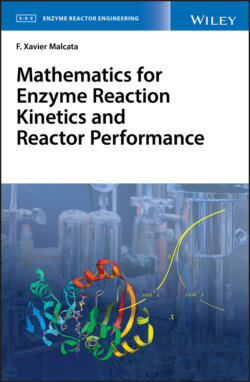Читать книгу Mathematics for Enzyme Reaction Kinetics and Reactor Performance - F. Xavier Malcata - Страница 12
Series Preface
ОглавлениеAd augusta per angusta.
(Toward the top, through hard work)
Comprehensive mathematical simulation – using mechanistic models as far as possible, constitutes an essential contribution to rationally characterize performance, as well as support design and drive optimization of any enzyme reactor. However, too often studies available in the literature – including text and reference books, deal with extensive modelling of chemical reactors that employ inorganic catalysts, or instead present extensive kinetic analysis of enzymes acting only (and implicitly) in batch apparatuses. Although constraining from an engineering perspective, this status quo is somewhat expected – because chemical engineers typically lack biochemical background, while biochemists miss engineering training. Meanwhile, rising environmental concerns and stricter legislation worldwide have urged the industry to resort to more sustainable, efficient, and cleaner processes – which tend to mimic natural (i.e. enzyme‐mediated) pathways; they generate essentially no polluting effluents or residues, require mild conditions of operation, and exhibit low‐energy requirements – while taking advantage of the extremely high activity and unique substrate selectivity of enzymes. The advent of genetic engineering has also dramatically contributed to drop the unit price, and enlarge the portfolio of enzymes available for industrial purposes, via overexpression in transformed microorganisms and development of sophisticated purification techniques; and advances in molecular engineering have further permitted specific features, in terms of performance and stability, be imparted to enzymes for tailored uses, besides overcoming their intrinsic susceptibility to decay.
An innovative approach is thus in order, where fundamental and applied aspects pertaining to enzyme reactors are comprehensively tackled – built upon mathematical simulation, and encompassing various ideal and nonideal configurations, presented and discussed in a consistent and pragmatic way. Enzyme Reactor Engineering pursues this goal, and accordingly conveys the most integrated and complete treatment of the subject of enzyme reactors to date; it will likely materialize a qualitative leap toward more effective strategies of describing, designing, and optimizing said reactors. More than a mere description of technology, true engineering aspects departing from first principles are put forward, and their rationale is systematically emphasized – with special attention paid to stepwise derivation of the underlying equations, so as to permit a self‐paced learning program by any student possessing elementary knowledge of algebra, calculus, and statistics. A careful selection of mathematical tools deemed useful for enzyme reactors is also provided in dedicated volumes, for the more inquisitive students and practitioners – in a straightforward, yet fully justified manner. Furthermore, appropriate examples, based (at least) on Michaelis and Menten’s enzymatic kinetics and first‐order enzyme decay, are worked out in full – for their being representative of industrial situations, while exhibiting a good compromise between practical applicability and mathematical simplicity. In this regard, the present book collection represents an unparalleled way of viewing enzyme reactors – clearly focused on the reactor component but prone to build an integrated picture, including mixture via momentum and mass transfer, and subsequent transformation via chemical reaction, with underlying enthalpic considerations as found necessary.
In a word, Enzyme Reactor Engineering attempts to contribute to a thorough understanding of the engineering concepts behind enzyme reactors – framed by a rigorous mathematical and physically consistent approach, and based on mechanistic expressions describing physical phenomena and typical expressions for enzyme‐mediated kinetics and enzyme decay. It takes advantage of a multiplicity of mathematical derivations, but ends up with several useful formulae while highlighting general solutions; and covers from basic definitions and biochemical concepts, through ideal models of flow, eventually to models of actual reactor behavior – including interaction with physical separation and external control. The typical layout of each chapter accordingly includes: introductory considerations, which set the framework for each theme in terms of relevance; objective definition, which entails specific goals and usefulness of ensuing results; and mathematical stepwise development, interwoven with clear physicochemical discussion (wherever appropriate), which resort to graphical interpretations and present step‐by‐step proofs to eventually generate (duly highlighted) milestone formulae. All in all, such an approach is aimed at helping one grasp the essence of descriptive functions, as well as the meaning behind hypothesized parameters and attained optima. Selected papers, chapters, or books are listed at the end, for more in‐depth, complementary reading – aimed at reinforcing global overviews.
Enzyme Reactor Engineering is organized as four major sets, which support a self‐consistent and ‐contained book collection: Enzyme Reaction Kinetics and Reactor Performance, Analysis of Enzyme Reaction Kinetics, Analysis of Enzyme Reactor Performance, and Mathematics for Enzyme Reaction Kinetics and Reactor Performance. Such a philosophy is primarily intended to help the prospective learner evolve in their knowledge acquisition steps – although it also constitutes standard material suitable for instructors; and allows the reader to first grasp the supporting concepts before proceeding to a deeper and deeper insight on the detailed kinetics of reactions brought about by generic enzymes, and eventually extending said concepts to overall reactor operation using enzymes. Three levels of description are indeed apparent and sequentially considered in the core of this book collection: macroscopic, or ideal; microscopic, or nonideal in terms of hydrodynamics (including homogeneous, nontrivial flow patterns) and mass transfer (including multiphasic systems); and submicroscopic, or nonideal in terms of mixing. The quality of the approximation increases in this order – but so does the complexity of the mathematical models entertained, and the thoroughness of the experimental data required thereby.
This treatise on reactors, using enzymes as catalysts, should be usable by and useful to both (advanced) undergraduate and graduate students interested in the fascinating field of white biotechnology, and typically enrolled in chemical or biochemical engineering degrees; as well as industrial practitioners involved in conceptual design or concerned with rational optimization of enzyme‐mediated processes. Enzyme Reactor Engineering has been conceived for hybrid utilization as both text and reference – since virtually all topics of relevance for enzyme reactors are addressed to some extent, and carefully related to each other.
F. Xavier Malcata Professor of Chemical Engineering University of Porto (Portugal)
